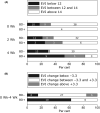Reduced expiratory variability index (EVI) is associated with controller medication withdrawal and symptoms in wheezy children aged 1-5 years
- PMID: 32068911
- PMCID: PMC7497189
- DOI: 10.1111/pai.13234
Reduced expiratory variability index (EVI) is associated with controller medication withdrawal and symptoms in wheezy children aged 1-5 years
Abstract
Background: Lung function testing is an essential part of diagnostic workup and monitoring of asthma, but young children are lacking easy, routine testing methods. However, recent discoveries show reduced tidal breathing variability measured using impedance pneumography (IP) at home during sleep as a sign of airway obstruction. In this study, we assessed (a) the discriminative capacity of expiratory variability index (EVI) between healthy controls and young children with recurrent wheeze on-and-off controller medication, (b) association between EVI and parentally perceived obstructive symptoms (need for bronchodilator) and (c) measurement success rate.
Methods: We included 68 patients (aged 1.0-5.6) and 40 healthy controls (aged 1.0-5.9 years). The patients were prescribed a three-month inhaled corticosteroid (ICS) treatment due to recurrent obstructive bronchitis. We measured EVI using IP at home at the end of the treatment (0W) and 2 (2W) and 4 (4W) weeks after ICS withdrawal.
Results: EVI was higher in controls than in patients, and significant within-patient reduction occurred at 4W as compared to 2W or 0W. Area under curve of the ROC curve (controls vs all patients) at 4W was 0.78 (95% CI 0.70-0.85). Children who were administered bronchodilator by parental decision had lower EVI than those without bronchodilator need at 4W, but not at 0W or 2W. Patients with parent-reported airway infection, but no bronchodilator need, had normal EVI. Measurement success rate was 94%.
Conclusion: EVI was lower in patients than in controls and it reduced further after controller medication withdrawal, especially in the presence of parentally perceived wheeze symptoms. This technique shows a significant potential for routine lung function testing of wheezy young children.
Keywords: asthma; home monitoring; lung function; obstruction; paediatric; tidal breathing; wheeze.
© 2020 The Authors. Pediatric Allergy and Immunology published by John Wiley & Sons Ltd.
Conflict of interest statement
VPS and JV hold patents relating to impedance pneumography. VPS and AH are employees of Revenio Group Corporation that commercialises impedance pneumography technology. JK reports personal fees from AstraZeneca, Boehringer Ingelheim, Chiesi, GlaxoSmithKline, Mundipharma, Novartis, Orion Pharma and Teva outside the submitted work. MP, JK and JGT have no conflict of interest to disclose.
Figures




Similar articles
-
Expiratory variability index (EVI) is associated with the severity of acute bronchial obstruction in small children: A proof-of-concept study.Pediatr Allergy Immunol. 2020 Aug;31(6):636-642. doi: 10.1111/pai.13257. Epub 2020 May 13. Pediatr Allergy Immunol. 2020. PMID: 32307738 Free PMC article.
-
Tidal breathing flow volume profiles during sleep in wheezing infants measured by impedance pneumography.J Appl Physiol (1985). 2019 May 1;126(5):1409-1418. doi: 10.1152/japplphysiol.01007.2018. Epub 2019 Feb 14. J Appl Physiol (1985). 2019. PMID: 30763165
-
Tidal changes in respiratory resistance are sensitive indicators of airway obstruction in children.Thorax. 2016 Oct;71(10):907-15. doi: 10.1136/thoraxjnl-2015-208182. Epub 2016 May 13. Thorax. 2016. PMID: 27178219
-
Management of Recurrent Preschool, Doctor-Diagnosed Wheeze.Indian J Pediatr. 2018 Aug;85(8):658-666. doi: 10.1007/s12098-017-2537-4. Epub 2018 Jan 8. Indian J Pediatr. 2018. PMID: 29308548 Review.
-
[Beta 2 agonists in infants and young children with a wheeze: often ineffective].Ned Tijdschr Geneeskd. 2003 Nov 8;147(45):2212-5. Ned Tijdschr Geneeskd. 2003. PMID: 14640058 Review. Dutch.
Cited by
-
Observational study of inhaled corticosteroid treatment for improved expiratory variability index in steroid-naïve asthmatic children.ERJ Open Res. 2021 Feb 7;8(1):00499-2021. doi: 10.1183/23120541.00499-2021. eCollection 2022 Jan. ERJ Open Res. 2021. PMID: 35141323 Free PMC article.
-
Expiratory variability index is associated with asthma risk, wheeze and lung function in infants with recurrent respiratory symptoms.ERJ Open Res. 2020 Oct 19;6(4):00167-2020. doi: 10.1183/23120541.00167-2020. eCollection 2020 Oct. ERJ Open Res. 2020. PMID: 33123560 Free PMC article.
-
Expiratory variability index (EVI) is associated with the severity of acute bronchial obstruction in small children: A proof-of-concept study.Pediatr Allergy Immunol. 2020 Aug;31(6):636-642. doi: 10.1111/pai.13257. Epub 2020 May 13. Pediatr Allergy Immunol. 2020. PMID: 32307738 Free PMC article.
References
-
- NHLBI Expert Panel Report 3 (EPR‐3): guidelines for the diagnosis and management of asthma‐summary report 2007. J Allergy Clin Immunol. 2007;120(5 Suppl):S94‐S138. - PubMed
-
- Gustafsson PM, Watson L, Davis KJ, Rabe KF. Poor asthma control in children: evidence from epidemiological surveys and implications for clinical practice. Int J Clin Pract. 2006;60(3):321‐334. - PubMed
-
- Vahlkvist S, Inman MD, Pedersen S. Effect of asthma treatment on fitness, daily activity and body composition in children with asthma. Allergy. 2010;65(11):1464‐1471. - PubMed
-
- Milton B, Whitehead M, Holland P, Hamilton V. The social and economic consequences of childhood asthma across the lifecourse: a systematic review. Child Care Health Dev. 2004;30(6):711‐728. - PubMed

